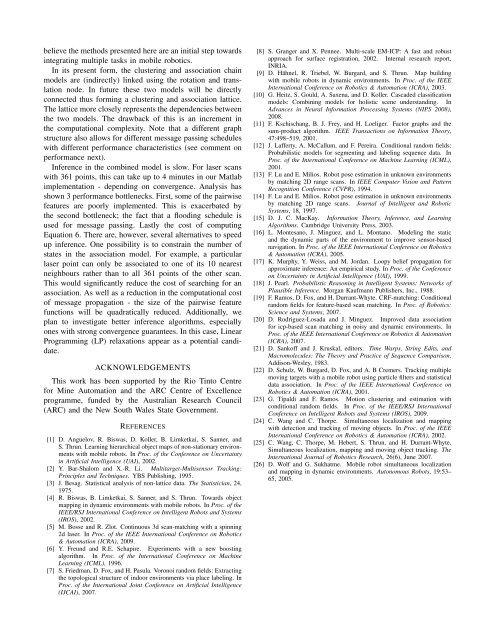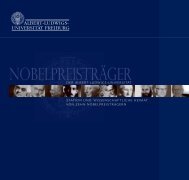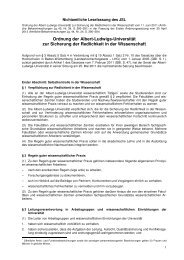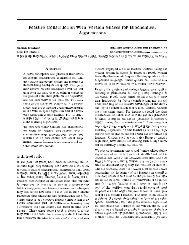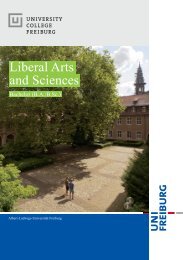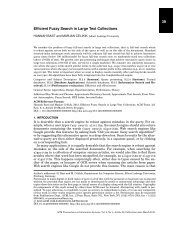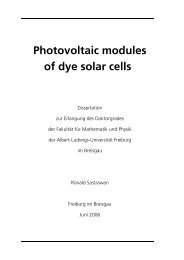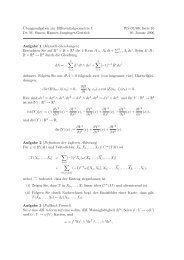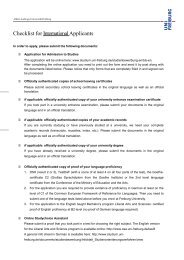An Integrated Probabilistic Model for Scan-Matching, Moving Object ...
An Integrated Probabilistic Model for Scan-Matching, Moving Object ...
An Integrated Probabilistic Model for Scan-Matching, Moving Object ...
You also want an ePaper? Increase the reach of your titles
YUMPU automatically turns print PDFs into web optimized ePapers that Google loves.
elieve the methods presented here are an initial step towardsintegrating multiple tasks in mobile robotics.In its present <strong>for</strong>m, the clustering and association chainmodels are (indirectly) linked using the rotation and translationnode. In future these two models will be directlyconnected thus <strong>for</strong>ming a clustering and association lattice.The lattice more closely represents the dependencies betweenthe two models. The drawback of this is an increment inthe computational complexity. Note that a different graphstructure also allows <strong>for</strong> different message passing scheduleswith different per<strong>for</strong>mance characteristics (see comment onper<strong>for</strong>mance next).Inference in the combined model is slow. For laser scanswith 361 points, this can take up to 4 minutes in our Matlabimplementation - depending on convergence. <strong>An</strong>alysis hasshown 3 per<strong>for</strong>mance bottlenecks. First, some of the pairwisefeatures are poorly implemented. This is exacerbated bythe second bottleneck; the fact that a flooding schedule isused <strong>for</strong> message passing. Lastly the cost of computingEquation 6. There are, however, several alternatives to speedup inference. One possibility is to constrain the number ofstates in the association model. For example, a particularlaser point can only be associated to one of its 10 nearestneighbours rather than to all 361 points of the other scan.This would significantly reduce the cost of searching <strong>for</strong> anassociation. As well as a reduction in the computational costof message propagation - the size of the pairwise featurefunctions will be quadratically reduced. Additionally, weplan to investigate better inference algorithms, especiallyones with strong convergence guarantees. In this case, LinearProgramming (LP) relaxations appear as a potential candidate.ACKNOWLEDGEMENTSThis work has been supported by the Rio Tinto Centre<strong>for</strong> Mine Automation and the ARC Centre of Excellenceprogramme, funded by the Australian Research Council(ARC) and the New South Wales State Government.REFERENCES[1] D. <strong>An</strong>guelov, R. Biswas, D. Koller, B. Limketkai, S. Sanner, andS. Thrun. Learning hierarchical object maps of non-stationary environmentswith mobile robots. In Proc. of the Conference on Uncertaintyin Artificial Intelligence (UAI), 2002.[2] Y. Bar-Shalom and X.-R. Li. Multitarget-Multisensor Tracking:Principles and Techniques. YBS Publishing, 1995.[3] J. Besag. Statistical analysis of non-lattice data. The Statistician, 24,1975.[4] R. Biswas, B. Limketkai, S. Sanner, and S. Thrun. Towards objectmapping in dynamic environments with mobile robots. In Proc. of theIEEE/RSJ International Conference on Intelligent Robots and Systems(IROS), 2002.[5] M. Bosse and R. Zlot. Continuous 3d scan-matching with a spinning2d laser. In Proc. of the IEEE International Conference on Robotics& Automation (ICRA), 2009.[6] Y. Freund and R.E. Schapire. Experiments with a new boostingalgorithm. In Proc. of the International Conference on MachineLearning (ICML), 1996.[7] S. Friedman, D. Fox, and H. Pasula. Voronoi random fields: Extractingthe topological structure of indoor environments via place labeling. InProc. of the International Joint Conference on Artificial Intelligence(IJCAI), 2007.[8] S. Granger and X. Pennee. Multi-scale EM-ICP: A fast and robustapproach <strong>for</strong> surface registration, 2002. Internal research report,INRIA.[9] D. Hähnel, R. Triebel, W. Burgard, and S. Thrun. Map buildingwith mobile robots in dynamic environments. In Proc. of the IEEEInternational Conference on Robotics & Automation (ICRA), 2003.[10] G. Heitz, S. Gould, A. Saxena, and D. Koller. Cascaded classificationmodels: Combining models <strong>for</strong> holistic scene understanding. InAdvances in Neural In<strong>for</strong>mation Processing Systems (NIPS 2008),2008.[11] F. Kschischang, B. J. Frey, and H. Loeliger. Factor graphs and thesum-product algorithm. IEEE Transactions on In<strong>for</strong>mation Theory,47:498–519, 2001.[12] J. Lafferty, A. McCallum, and F. Pereira. Conditional random fields:<strong>Probabilistic</strong> models <strong>for</strong> segmenting and labeling sequence data. InProc. of the International Conference on Machine Learning (ICML),2001.[13] F. Lu and E. Milios. Robot pose estimation in unknown environmentsby matching 2D range scans. In IEEE Computer Vision and PatternRecognition Conference (CVPR), 1994.[14] F. Lu and E. Milios. Robot pose estimation in unknown environmentsby matching 2D range scans. Journal of Intelligent and RoboticSystems, 18, 1997.[15] D. J. C. MacKay. In<strong>for</strong>mation Theory, Inference, and LearningAlgorithms. Cambridge University Press, 2003.[16] L. Montesano, J. Minguez, and L. Montano. <strong>Model</strong>ing the staticand the dynamic parts of the environment to improve sensor-basednavigation. In Proc. of the IEEE International Conference on Robotics& Automation (ICRA), 2005.[17] K. Murphy, Y. Weiss, and M. Jordan. Loopy belief propagation <strong>for</strong>approximate inference: <strong>An</strong> empirical study. In Proc. of the Conferenceon Uncertainty in Artificial Intelligence (UAI), 1999.[18] J. Pearl. <strong>Probabilistic</strong> Reasoning in Intelligent Systems: Networks ofPlausible Inference. Morgan Kaufmann Publishers, Inc., 1988.[19] F. Ramos, D. Fox, and H. Durrant-Whyte. CRF-matching: Conditionalrandom fields <strong>for</strong> feature-based scan matching. In Proc. of Robotics:Science and Systems, 2007.[20] D. Rodriguez-Losada and J. Minguez. Improved data association<strong>for</strong> icp-based scan matching in noisy and dynamic environments. InProc. of the IEEE International Conference on Robotics & Automation(ICRA), 2007.[21] D. Sankoff and J. Kruskal, editors. Time Warps, String Edits, andMacromolecules: The Theory and Practice of Sequence Comparison.Addison-Wesley, 1983.[22] D. Schulz, W. Burgard, D. Fox, and A. B Cremers. Tracking multiplemoving targets with a mobile robot using particle filters and statisticaldata association. In Proc. of the IEEE International Conference onRobotics & Automation (ICRA), 2001.[23] G. Tipaldi and F. Ramos. Motion clustering and estimation withconditional random fields. In Proc. of the IEEE/RSJ InternationalConference on Intelligent Robots and Systems (IROS), 2009.[24] C. Wang and C. Thorpe. Simultaneous localization and mappingwith detection and tracking of moving objects. In Proc. of the IEEEInternational Conference on Robotics & Automation (ICRA), 2002.[25] C. Wang, C. Thorpe, M. Hebert, S. Thrun, and H. Durrant-Whyte.Simultaneous localization, mapping and moving object tracking. TheInternational Journal of Robotics Research, 26(6), June 2007.[26] D. Wolf and G. Sukhatme. Mobile robot simultaneous localizationand mapping in dynamic environments. Autonomous Robots, 19:53–65, 2005.


